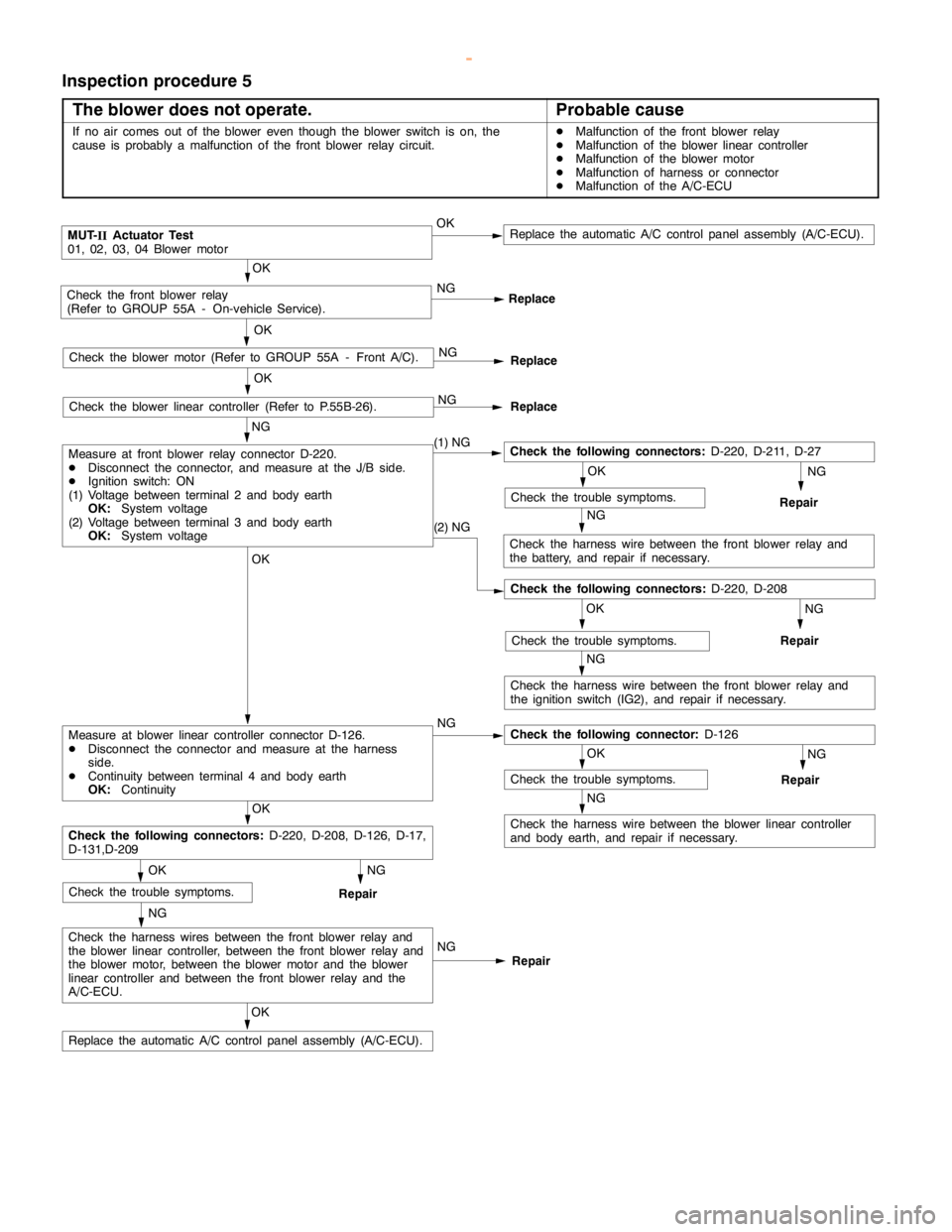2000 MITSUBISHI MONTERO service
[x] Cancel search: servicePage 1694 of 1839

SWS -Troubleshooting54B-8
TROUBLESHOOTING
STANDARD FLOW OF DIAGNOSTIC TROUBLESHOOTING
Refer to GROUP 00 – How to Use Troubleshooting/Inspection Service Points.
DIAGNOSTIC FUNCTION
DIAGNOSIS CODES CHECK
Use the MUT-II
to check a diagnosis code.
(Refer to GROUP 00 – How to Use Troubleshooting/Inspection Service Points.)
NOTE
Connect the MUT-II
to the 16-pin diagnosis connector (black).
INPUT SIGNAL CHECK
1. Use the MUT-II
to check a input signal.
(Refer to GROUP 00 – How to Use Troubleshooting/Inspection Service Points.)
2. In this condition, the following input switches can be checked.
3. If an abnormality is found during the input signal check, carry out troubleshooting while referring
to the Trouble Symptom Check page.
Input Signal Check Function
Input signalBuzzer operation condition
Ignition switch (ACC)Turned from LOCK(OFF) to ACC
Ignition switch (IG1)Turned from ACC to ON
Key reminder switch
(from inserted position)
Hazard warning lamp switchTurned from OFF to ON
Front fog lamp switch
Rear fog lamp switch
Back-up lamp switch
Inhibitor switch (reverse)
washer>Selector lever moved to R position
Rear wiper motor auto-stop signal
is sent before the rear wiper begins to operate)
Driver’s door switchDriver’s door opened from closed condition
Door switchesAll doors closed to any door opened
Front passenger’s or back door lock key cylinder switch
Driver’s door lock actuator switch
position to unlock position or vice versa
www.WorkshopManuals.co.uk
Purchased from www.WorkshopManuals.co.uk
Page 1746 of 1839

SWS -On-vehicle Service54B-60
ON-VEHICLE SERVICE
ADJUSTMENT PROCEDURES OF SWS FUNCTION
Through special operation of input switches, it is possible to disable and enable the functions listed below.
Settings are retained even if the battery is disconnected.
DKeyless entry hazard answerback function
DInitialization of above mentioned functions
Configuration Mode Entry Conditions
1. Set each switch at the following condition.
DHazard warning lamp switch: OFF
DDiagnosis control: ON (MUT-II
connected or terminal 1 of diagnosis connector connected to earth)
DKey reminder switch: OFF (ignition key inserted)
DIgnition switch: LOCK (OFF)
DDriver’s door switch: OFF (driver’s door closed)
2. When the windshield washer switch is continuously turned ON for more than 10 seconds, the buzzer
integrated in the ETACS-ECU sounds once and the mode is switched to the configuration mode.
Configuration Mode Cancellation Conditions
The ETACS-ECU cancels the configuration mode when any of the conditions listed below is satisfied.
DDiagnosis control: OFF (MUT-II
disconnected or terminal 1 of diagnosis connector disconnected from
earth)
DKey reminder switch: ON (ignition key removed)
DIgnition switch: any position other than LOCK (OFF)
DDriver’s door switch: ON (driver’s door open)
DNo configuration performed within three minutes of entry to configuration mode (If configuration is
performed within first three minutes, monitoring continues for three minutes from that point.)
Configuration of Functions
FunctionConfiguration procedure
Keyless entry hazard
answerbackIf the transmitter’s LOCK switch is turned ON twice within two seconds, the lock answerback
function’s enabled/disabled status is inverted.
D
When function is enabled, buzzer sounds once (initial status).
D
When function is disabled, buzzer sounds twice.
If the transmitter’s UNLOCK switch is turned ON twice within two seconds, the unlock
answerback function’s enabled/disabled status is inverted.
D
When function is enabled, buzzer sounds once (initial status).
D
When function is disabled, buzzer sounds twice.
Initialization of above
mentioned functionsIf the windshield washer switch is turned ON for more than 20 seconds, the buzzer sounds
twice and all functions are initialized. (The configuration mode entry buzzer sounds after 10
seconds, but the switch must be kept ON for 20 seconds to achieve initialization.)
IF the windshield washer switch ins kept ON for more than 20 seconds without prior entry
of the configuration mode, the configuration mode is entered after 10 seconds and
initialization does not take place.
www.WorkshopManuals.co.uk
Purchased from www.WorkshopManuals.co.uk
Page 1748 of 1839

55A-2
HEATER, AIR
CONDITIONER AND
VENTILATION
CONTENTS
SERVICE SPECIFICATIONS 3.................
LUBRICANTS 3..............................
TROUBLESHOOTING
TROUBLESHOOTING
ON-VEHICLE SERVICE 9.....................
Refrigerant Level Test through Performance Test 9.
Magnetic Clutch Test 10.........................
Receiver Drier Test 10..........................
Compressor Drive Belt Adjustment 10.............
Dual Pressure Switch Check 10..................
Charging 11...................................
Performance Test 15............................
Front Blower Relay and Rear Blower Relay
Continuity Check 18............................
Continuity Check of A/C Compressor Relay and
Condernser Fan Relay 18.......................
PTC Heater Relay Continuity Check 19...........
Idle-up Operation Check
Vacuum Actuator Check
Idle-up Solenoid Valve Check 21.................
Clean Air Filter Replacement Procedure 22........
FRONT A/C 23..............................
Air Conditioner Control Panel Assembly and
A/C Switch 23.................................
Heater Unit and Blower Assembly 26.............
Blower Motor and Resistor 29....................
Inside/Outside Air Changeover Damper Motor 30...
Automatic Compressor-ECU and
Air Thermo Sensor Assembly 31.................
REAR HEATER AND REAR COOLER 32.....
Rear A/C Switch, Front Rear Fan Switch 32.......
Rear A/C Control Unit 34........................
Rear Heater Unit 34............................
Rear Heater Unit and Rear Blower Assembly 37....
HEAT SWITCH 40...........................
COMPRESSOR 41...........................
CONDENSER ASSEMBLY AND
CONDENSER FAN 45........................
REFRIGERANT LINE 47.....................
ENGINE COOLANT TEMPERATURE SWITCH
51 ..........................................
IDLE-UP SYSTEM 53........................
DUCTS 54..................................
VENTILATION 56............................
www.WorkshopManuals.co.uk
Purchased from www.WorkshopManuals.co.uk
Page 1749 of 1839

HEATER, AIR CONDITIONER AND VENTILATION - Service Specifications/Lubricants55A-3
SERVICE SPECIFICATIONS
ItemStandard value
Idle speed r/minDiesel4D56750±100
(N or P range)4M41750±50
Idle-up speed r/min4D56925±25
(N or P range)4M41A/CWhen the
A/C is under
low or me-
dium load800±50
When the1,000±50
A/C is under
high load
Water temperature switch_CA/C cut-offON108
OFF11 5
Condenser fanOFF97
ON102
Resistor resistance (Front A/C)WBetween terminals 2 and 40.39±7%
Between terminals 1 and 21.49±7%
Between terminals 2 and 32.79±7%
Resistance of the rear air conditioner switch (temperature control switch) kW
Potentiometer for air mix damper kW
Resistor resistance [Rear heater (frontBetween terminals 1 and 64.9±7%
console)]WBetween terminals 1 and 31.25±7%
Resistor resistance [Rear heater (quarterBetween terminals 1 and 64.9±7%
trim), rear heater]WBetween terminals 1 and 31.25±7%
Idle-up solenoid valve resistanceW40
Air compressor air gap mm0.35 - 0.65
LUBRICANTS
ItemSpecified lubricantsQuantity
Compressor oil mLExcept for vehicles with rear coolerDENSO OIL 8120±20
Vehicles with rear coolerDENSO OIL 8140±20
Pipe connectionsDENSO OIL 8As required
Refrigerant gExcept for vehicles with rear coolerR134a (HFC-134a)500±20
Vehicles with rear coolerR134a (HFC-134a)780±20
www.WorkshopManuals.co.uk
Purchased from www.WorkshopManuals.co.uk
Page 1763 of 1839

HEATER, AIR CONDITIONER AND VENTILATION - On-vehicle Service55A-17
REFRIGERANT LEAK REPAIR
LOST CHARGE
If the system has lost all charge due to a leak:
1. Evacuate the system. (See procedure.)
2. Charge the system with approximately one
pound of refrigerant.
3. Check for leaks.
4. Discharge the system.
5. Repair leaks.
6. Replace receiver drier.
Caution
Replacement filter-drier units must be
sealed while in storage. The drier used in
these units will saturate water quickly upon
exposure to the atmosphere. When
installing a drier, have all tools and supplies
ready for quick reassembly to avoid keeping
the system open any longer than necessary.
7. Evacuate and charge system.
LOW CHARGE
If the system has not lost all of its refrigerant charge;
locate and repair all leaks. If it is necessary to
increase the system pressure to find the leak
(because of an especially low charge) add
refrigerant. If it is possible to repair the leak without
discharging the refrigerant system, use the
procedure for correcting low refrigerant level.HANDLING TUBING AND FITTINGS
Kinks in the refrigerant tubing or sharp bends in
the refrigerant hose lines will greatly reduce the
capacity of the entire system. High pressures are
produced in the system when it is operating.
Extreme care must be exercised to make sure that
all connections are pressure tight. Dirt and moisture
can enter the system when it is opened for repair
or replacement of lines or components. The
following precautions must be observed. The
system must be completely discharged before
opening any fitting of connection in the refrigeration
system. Open fittings with caution even after the
system has been discharged. If any pressure is
noticed as a fitting is loosened, allow trapped
pressure to bleed off very slowly.
Never attempt to rebend formed lines to fit. Use
the correct line for the installation you are servicing.
A good rule for the flexible hose lines is keep the
radius of all bends at least 10 times the diameter
of the hose.
Sharper bends will reduce the flow of refrigerant.
The flexible hose lines should be routed so that
they are at least 80 mm from the exhaust manifold.
It is good practice to inspect all flexible hose lines
at least once a year to make sure they are in good
condition and properly routed.
Unified plumbing connections with O-rings, these
O-rings are not reusable.
COMPRESSOR NOISE
You must first know the conditions when the noise
occurs. These conditions are: weather, vehicle
speed, in gear or neutral, engine temperature or
any other special conditions.
Noises that develop during A/C operation can often
be misleading. For example: what sounds like a
failed front bearing or connecting rod, may be
caused by loose bolts, nuts, mounting brackets,
or a loose clutch assembly. Verify accessory drive
belt tension (power steering or alternator).
Improper accessory drive belt tension can cause
a misleading noise when the compressor is
engaged and little or no noise when the compressor
is disengaged.
Drive belts are speed-sensitive. That is, at different
engine speeds, and depending upon belt tension,
belts can develop unusual noises that are often
mistaken for mechanical problems within the
compressor.ADJUSTMENT
1. Select a quiet area for testing. Duplicate
conditions as much as possible. Switch
compressor on and off several times to clearly
identify compressor noise. To duplicate high
ambient conditions (high head pressure),
restrict air flow through condenser. Install
manifold gauge set to make sure discharge
pressure doesn’t exceed 2,070 kPa.
2. Tighten all compressor mounting bolts, clutch
mounting bolt, and compressor drive belt.
Check to assure clutch coil is tight (no rotation
or wobble).
3. Check refrigerant hoses for rubbing or
interference that can cause unusual noises.
4. Check refrigerant charge. (See “Charging
System”.)
5. Recheck compressor noise as in Step 1.
6. If noise still exists, loosen compressor mounting
bolts and retorque. Repeat Step 1.
7. If noise continues, replace compressor and
repeat Step 1.
www.WorkshopManuals.co.uk
Purchased from www.WorkshopManuals.co.uk
Page 1804 of 1839

55B-1
HEATER, AIR
CONDITIONER AND
VENTILATION
CONTENTS
SERVICE SPECIFICATIONS 2.................
LUBRICANTS 2..............................
SPECIAL TOOLS 3...........................
TROUBLESHOOTING
TROUBLESHOOTING
ON-VEHICLE SERVICE 24...................
Magnetic Clutch Test 24.........................
Idle Up Operation Check
FRONT A/C 25..............................
Automatic A/C Control Panel Assembly
(A/C-ECU) 25..................................Blower Linear Controller 26......................
Air Mix Damper Motor and
Air Outlet Changeover Damper Motor 27..........
Heater Water Temperature Sensor 29.............
PHOTO SENSOR 30........................
OUTSIDE AIR TEMPERATURE SENSOR 30..
REAR A/C 30...............................
Electric Motor for Air Outlet Changeover
Damper 30....................................
REFRIGERANT LINE 31.....................
COMPRESSOR 33...........................
www.WorkshopManuals.co.uk
Purchased from www.WorkshopManuals.co.uk
Page 1805 of 1839

HEATER, AIR CONDITIONER AND VENTILATION -Service Specifications/Lubricants55B-2
SERVICE SPECIFICATIONS
ItemStandard value
Resistance value of the potentiometer for the air mix damper (front A/C) kWApprox. 0.96 - 5.76
Resistance value of the potentiometer for the air outlet changeover damper (front A/C)
kWApprox. 0.96 - 5.76
Resistance of the rear air conditioner switch (temperature control switch)
Resistance of the potentiometer for the air mix damper
Resistance value of the resistor (rear A/C)Between terminals 1 and 64.9±7%
WBetween terminals 1 and 31.25±7%
Air compressor air gap mm0.35 - 0.65
Idle speed r/min (N or P range)Petrol600±50
Idle-up speed r/min (N or P range)PetrolWhen the A/C is under
low load700±50
When the A/C is under
medium load800±50
When the A/C is under
high load1,000±50
LUBRICANTS
ItemBrandQuantity
Compressor oil mlSingle A/C
Single air conditioner
Pipe connectionsDENSO OIL 8As required
Refrigerant gSingle A/C
Single air conditioner
www.WorkshopManuals.co.uk
Purchased from www.WorkshopManuals.co.uk
Page 1814 of 1839

HEATER, AIR CONDITIONER AND VENTILATION -Troubleshooting
Inspection procedure 5
The blower does not operate.
Probable cause
If no air comes out of the blower even though the blower switch is on, the
cause is probably a malfunction of the front blower relay circuit.DMalfunction of the front blower relay
DMalfunction of the blower linear controller
DMalfunction of the blower motor
DMalfunction of harness or connector
DMalfunction of the A/C-ECU
NG
Repair
NG
Repair
NG
Repair
NG
Check the harness wire between the front blower relay and
the ignition switch (IG2), and repair if necessary.
NG
Check the harness wire between the front blower relay and
the battery, and repair if necessary.
NG
Repair
NG
Check the harness wire between the blower linear controller
and body earth, and repair if necessary.
OK
Replace the automatic A/C control panelassembly (A/C-ECU).
NG
Check the harness wires between the front blower relay and
the blower linear controller, between the front blower relay and
the blower motor, between the blower motor and the blower
linear controller and between the front blower relay and the
A/C-ECU.NG
Repair
OK
Check the trouble symptoms.
OK
Check the following connectors:D-220, D-208, D-126, D-17,
D-131,D-209
OK
Check the trouble symptoms.
OK
Measure at blower linear controller connector D-126.
DDisconnect the connector and measure at the harness
side.
DContinuity between terminal 4 and body earth
OK:ContinuityNGCheck the following connector:D-126
OK
Check the trouble symptoms.
Check the following connectors:D-220, D-208
(2) NG
OK
Check the trouble symptoms.
NG
Measure at front blower relay connector D-220.
DDisconnect the connector, and measure at the J/B side.
DIgnition switch: ON
(1) Voltage between terminal 2 and body earth
OK:System voltage
(2) Voltage between terminal 3 and body earth
OK:System voltage(1) NGCheck the following connectors:D-220, D-211, D-27
OK
Check the blower linear controller (Refer to P.55B-26).NG
Replace
OK
Check the blower motor (Refer to GROUP 55A - Front A/C).NG
Replace
OK
Check the front blower relay
(Refer to GROUP 55A - On-vehicle Service).NG
Replace
MUT-
IIActuator Test
01, 02, 03, 04 Blower motorOKReplace the automatic A/C control panelassembly (A/C-ECU).
www.WorkshopManuals.co.uk
Purchased from www.WorkshopManuals.co.uk